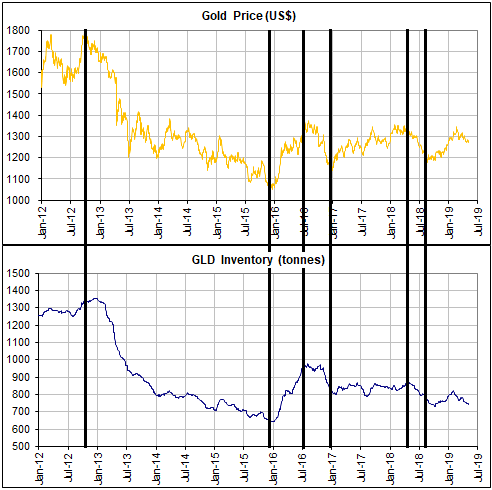An increase in the amount of gold bullion held by GLD (the SPDR Gold Shares) and other bullion ETFs does not cause the gold price to rise. The cause-effect works the other way around and in any case the amount of gold that moves in/out of the ETFs is always trivial compared to the metal’s total trading volume. However, it is reasonable to view the change in GLD’s gold inventory as a sentiment indicator.
Ironically, an increase in the amount of physical gold held by GLD and the other gold ETFs is indicative of increasing speculative demand for “paper gold”, not physical gold. As I explained in previous blog posts (for example, HERE), physical gold only ever gets added to GLD’s inventory when the price of a GLD share (a form of “paper gold”) outperforms the price of gold bullion. It happens as a result of an arbitrage trade that has the effect of bringing GLD’s market price back into line with its net asset value (NAV). Furthermore, the greater the demand for paper claims to gold (in the form of ETF shares) relative to physical gold, the greater the quantity of physical gold that gets added to GLD’s inventory to keep the GLD price in line with its NAV.
Speculators in GLD shares and other forms of “paper gold” (most notably gold futures) tend to become increasingly optimistic as the price rises and increasingly pessimistic as the price declines. That’s the explanation for the positive correlation between the gold price and GLD’s physical gold inventory illustrated by the following chart. That’s also why intermediate-term trend reversals in the GLD gold inventory tend to follow reversals in the gold price. The thick vertical lines on the following chart mark the intermediate-term trend reversals in the US$ gold price.
Interestingly, the increase in the GLD inventory that occurred in parallel with the most recent upward trend in the gold price was relatively small. This suggests that the price rally was driven more by increasing demand for physical gold than by increasing demand for paper gold. Furthermore, the minor downward correction in the gold price since the February-2019 short-term peak has been accompanied by a disproportionately large decline in GLD’s physical inventory. In fact, at the end of last week GLD held about 30 tonnes less gold than it did when the gold price was bottoming in the $1170s last August. Again, this suggests that the gold price has been supported by demand for the physical metal.
In terms of influence on the gold price, speculative trading of gold futures is vastly more important than speculative trading of GLD shares. Therefore, assumptions about paper versus physical demand shouldn’t be based solely on the change in the GLD inventory. The situation in the gold futures market also must be taken into account.
I won’t get into the details in this post, but changes in futures-market positioning and open interest over the past few months are consistent with the idea that the demand for physical gold has been strong relative to the demand for paper gold.
The relatively strong demand for physical gold does not imply that a big gold-price rally is coming, but it does imply that the downside price risk is low.
 Print This Post
Print This Post

